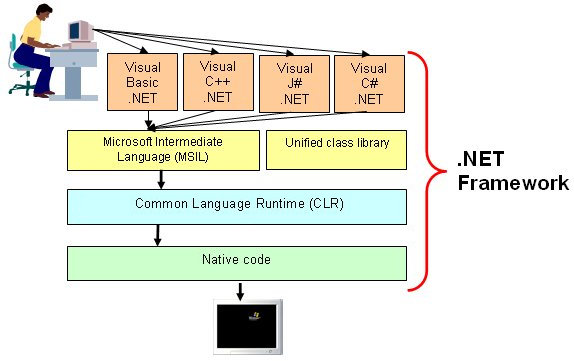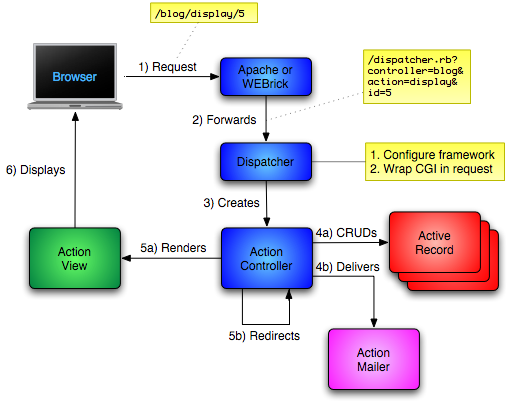
Tuolumne Meadows, California, USA
According to Jesse James Garrett, Ajax is not in itself a new technology: it's a technique that combines several Web technologies:
- Using XHTML and CSS for structure and presentation.
- Displaying and manipulating pages using Document Object Model (DOM).
- Using the browser's XMLHttpRequest object to transfer data between the client and server.
- Using XML as the format for the data transfer between the client and the server.
- Using JavaScript to dynamically display and interact with all of the above.
Crane et al. defined four defining principles of Ajax compared with the classic page-based application model.
- The browser host an application, not content.
- The server delivers data, not content.
- User interaction with the application can be fluid and continuous.
- Ajax is real coding and requires discipline.
According to Anthony T. Holdener III, Ajax is not the be-all and end-all solution to every new application being built for the Web.
...
Ajax is a great model for building more modern, faster Web 2.0 applications, but only when they are built correctly.
Throwing Ajax at every application can create complications,
such as accessibility issues, cross-browser compliance nightmares,
and requiring more intricate and complex programming to perform simple tasks.
The framework aims to alleviate the overhead associated with common activities performed in Web development
by easing the burden of writing all of the low-level coding details.
It is important to understand the differences among the various frameworks on the Web.
The Microsoft .NET Framework is positioned to be the development platform for all new Windows applications,
on the Web as well as the desktop.
Instead of being compiled into machine-level instructions,
.NET languages are first compiled into a common bytecode and then into a DLL.
When a .NET project is built, each .NET language has its own compiler that can interpret the language syntax.
These compilers rely on Common Language Specification (CLS) to govern the rules the language should live by.
They also rely on the Common Type System (CTS), which defines operations and types that the .NET language share.
The last one is the Framework Class Library (FCL) which .NET compilers are utilizing.

Taking all of these together, the compilers then compile the code into the bytecode
called the Common Intermediate Language(CIL>.
The CIL is commonly known as assemblies in .NET.
When the web server requests an assembly, the Common Language Runtime (CLR) is invoked.
Within CLR is where components such as JIT compiler, garbage collector, and security run.
The CLR is platform-specific, and it compiles the CIL into the machine code.
The CIL and CLR together are referred to as the Common Language Infrastructure (CLI).
Ruby on Rails (RoR or Rails is a web-based project collaboration tool.
It is based on the MVC pattern and it is considered to be a full-stack framework,
meaning that all the components in the framework are integrated,
so we don't have to set anything up manually.
Because the libraries the framework provides are easy to use and
are written so that they integrate well with one another,
web developing speed can be accelerated.

The ActiveRecord, a library, makes communicating with a database easy.
Rails also has the Action Pack, which consists of two libraries: ActionController and ActionView.
Ruby on Rails allows a web developer to focus on what he needs to: the application's functionality.
All of the details of database queries, hashing, caching, forms, tags, and even Ajax itself are taken care of,
leaving us free to focus on the functionality of our program.
Java frameworks are usually designed for the Java J2EE platform.
- Jakarta Struts
The core of the Struts framework is a flexible control layer based on standard technologies like
Java Servlets, JavaBeans, ResourceBundles, and XML, as well as various Jakarta Commons packages.
Struts encourages application architectures based on the Model 2 approach, a variation of the classic Model-View-Controller (MVC) design paradigm. - Spring
Spring is quickly growing out of its reputation as a lightweight framework.
Spring has gained popularity because it integrates so well with other things
besides the Java Enterprise platform. It has almost become too flexible,
and it does not have a central controller. - Tapestry
Tapestry is a young framework, but it has the philosophy
and MVC design that are driving many Ajax web applications.
- Django
the Web framework for perfectionists (with deadlines).
Django makes it easier to build better Web apps more quickly and with less code.
Django is a high-level Python Web framework that encourages rapid development and clean, pragmatic design.
It lets you build high-performing, elegant Web applications quickly.
Django focuses on automating as much as possible and adhering to the DRY (Don't Repeat Yourself) principle. - Zope
Being the granddaddy of Python web frameworks, Zope has grown into a family of frameworks over the years.
Zope 1 was released in 1999.
Zope 2 is both a web framework and a general purpose application server,
today it is primarily used by ContentManagementSystems.
Zope 3 is both a standalone framework and a collection of related libraries,
which are also included with newer releases of Zope 2.
All of the Zope frameworks include the ZODB, an object database for Python
- CakePHP CakePHP is easy to use and ideal for Ajax web applications.
- Zoop
- Zend This framework looks very promising as it continues to grow toward a stable release.
-
The XMLHttpRequest object
Specification by W3C, of the base of AJAX. -
OpenAjax Alliance
An organization of vendors, open source projects, and companies that are dedicated to the successful adoption of open and interoperable Ajax-based web technologies. Includes list of members, news, and details of events. -
Ajax Patterns
A wiki with principles, gotchas, frameworks, and common techniques. Also the homepage for the "Ajax Design Patterns" book. -
Agile Ajax
Provides news, reviews, tutorials and demos about AJAX with JQuery. -
Bindows
Provides a browser platform to help develop AJAX applications. -
AJAX Matters
An informational site providing Asynchronous JavaScript and XML development information including code libraries, sites using ajax, and books on ajax. -
AJAX Magazine
Reference for AJAX, Asynchronous Javascript and XML, with news, articles, tutorials, and implementations. -
Encosia
ASP.NET AJAX tutorials and code examples. -
Gaia Ajax Widgets
An ASP.NET 2.0 Ajax Widget library -
Stop using Ajax!
The author gives his opinion on when AJAX should be used on websites and when it shouldn't. -
Ajax.NET Professional Library
Ajax.NET Professional is the first available .NET AJAX framework. As it is working with .NET 1.1 and 2.0 and with all common web browsers including mobile devices it is one of the greatest libraries available. -
Ajax Projects
Ajax portal for all ajax projects frameworks toolkits and tutorials. -
Ajaxonomy
Weblog with tutorials and tips to develop Ajax applications. -
Ajaxlines
Ajaxlines is a project focused on providing its audience with a database of most of Ajax related articles, resources, tutorials and services from around the world. -
XMLHttpRequest and AJAX Applications - Fiftyfoureleven.com
A weblog with code snippets and proofs of concept. -
Aspects of AJAX
Aspects of AJAX is a platform and engine for developing responsive and interactive web applications by using and extending the browser platforms to a Rich Client System. -
AJAX Sample
Provides examples and tutorials to use AJAX technics with ASP.NET. -
AjaxApp.com
A forum-site for the discussion of interactive web-based application development based on Open Source Technology such as PHP, J2EE, DHTML and AJAX (Asynchronous JavaScript And XML)technology. -
AJAX Goals
AJAX community website featuring articles, books, blogs, news and libraries. -
Ajaxtalk
Asynchronous Javascript and XML discussion board. -
Ajax Impact
portal on Ajax containing news, articles, tutorials, toolkits, sites using Ajax, Ajax Demos etc. -
Sote Design using prototype
The Web 2.0 style website designing using Prototype Javascript framework -
Atlas
Provides the implementation of AJAX technology introduced by Microsoft.